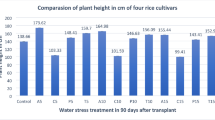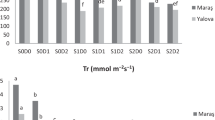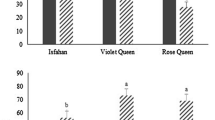Abstract
The study investigates the differential accumulation of osmolytes and their contribution to osmotic adjustment in leaf tissue of peanut under drought stress. Plants of four peanut cultivars, obtained from ICRISAT, with varying degrees of drought tolerance were subjected to 10, 15, and 20 days of drought stress by withholding irrigation to 20-day-old seedlings. Leaf samples were collected on 31st, 36th, and 41st days from these stressed plants along with their respective controls. The results indicated that ICGV 91114 was the most drought-tolerant variety followed by ICGS 76 and J 11, while JL 24 was the most drought susceptible. The leaves of ICGV 91114 maintained higher RWC and chlorophyll pigments under water stress compared to JL 24. The contents of all the biochemicals were found to be the maximum in ICGV 91114 and least in JL 24 during stress periods. Drought induced increase in the contents of TSS and TRS were significantly higher in ICGV 91114 under 15 days of water stress compared to the other three varieties and stress periods, while TLP, total free amino acids and total proline were higher in 20-day-old stressed plants of ICGV 91114 and the lowest in 10-day-old stressed plants of JL 24. In the control plants of all four varieties, there was a steady increase in the contents of all these biochemicals with an increase in the age of the plants. The results suggest that osmolytes act as important compatible solutes to maintain osmotic balance, to protect cellular macromolecules, and scavenge free radicals under water stress conditions.
Similar content being viewed by others
Abbreviations
- DAS:
-
days after sowing
- DNSA:
-
3,5-Dinitrosalicylic acid
- ds:
-
day stressed
- RWC:
-
relative water content
- TLP:
-
total leaf protein
- TNRS:
-
total non-reducing sugars
- TRS:
-
total reducing sugars
- TSS:
-
total soluble sugars
References
Alexieva V, Sergiev I, Mapelli S, Karanov E. 2001. The effect of drought and ultraviolet radiation on growth and stress markers in pea and wheat. Plant Cell Environ. 24: 1337–1344
Ali-Ahmad M, Basha SM. 1998. Effect of water stress on composition of peanut leaves. Peanut Sci. 25: 31–34
Anjum F, Yaseen M, Rasul E, Wahid A, Anjum S. 2003. Water stress in barley (Hordeumvulgare L.). II. Effect on chemical composition and chlorophyll contents. Pak. J. Agric. Sci. 40: 45–49
Araus JL, Slafer GA, Reynolds MP, Royo C. 2002. Plant breeding and water relations in C3 cereals: What should we breed for? Ann. Bot. 89: 925–940
Arnon DL. 1949. Copper enzymes in isolated chloroplast. Polyphenol oxidase in Beta vulgaries. Plant Physiol. 24: 1–15
Ashraf M, Harris PJC. 2004. Potential biochemical indicators of salinity tolerance in plants. Plant Sci. 166: 3–16
Ayerbe L, Tenorio JL. 1998. Turgor maintenance, osmostic adjustment and soluble sugar and proline accumulation in 49 pea cultivars in response to water stress. Field Crop Res. 59: 225–235
Bates LS, Waldren RP, Teare ID. 1973. Rapid determination of free proline for water stress studies. Plant Soil. 39: 205–207
Bohnert HJ, Nelson DE, Jensen RG. 1995. Adaptations to environmental stress. Plant Cell 7: 1099–1111
Bradford MM. 1976. A rapid and sensitive method for the quantitation of microgram quantities of protein utilizing the principle of protein-dye binding. Anal. Biochem. 72: 248–254
Chandler PM, Robertson M. 1994. Gene expression regulated by abscisic acid and its relation to stress tolerance. Annu. Rev. Plant Physiol. Plant Mol. Biol. 45: 113–141
Chaves MM, Maroco JP, Pereira JS. 2003. Understanding plant responses to drought from genes to the whole plant. Funct. Plant Biol. 30: 239–264
Choudhary NL, Sairam RK, Tyagi A. 2005. Expression of delta1-pyrroline-5-carboxylate synthetase gene during drought in rice (Oryza sativa L.). Ind. J. Biochem. Biophys. 42: 366–370
Dubois M, Gilles KA, Hamilton JK, Rebers PA, Smith F. 1956. Colorimetric method for determination of sugars and related substances. Anal. Chem. 28: 350–356
Farooq M, Basra SMA, Wahid A, Cheema ZA, Cheema MA, Khaliq A. 2009. Physiological role of exogenously applied glycinebetaine in improving drought tolerance of fine grain aromatic rice (Oryza sativa L.). J. Agron. Crop Sci. 194: 325–333
Gunes A, Inal A, Adak MS, Bagci EG, Cicek N, Eraslan F. 2008. Effect of drought stress implemented at pre- or post-anthesis stage some physiological as screening criteria in chickpea cultivars. Rus. J. Plant Physiol. 55: 59–67
Hakimi A, Monneveux P, Galiba G. 1995. Soluble sugars, proline and Relative Water Content (RWC) as traits for improving drought tolerance and divergent selection for RWC from T. polonicuminto T. durum. J. Genet. Breed. 49: 237–244
Hanson AD, Hitz WD. 1982. Metabolic responses to water stress. Ann. Rev. Plant Physiol. 33:163–303
Hanson AD, Wyse R. 1982. Biosynthesis, translocation and accumulation of betaine in sugar beet and its progenitors in relation to salinity. Plant Physiol. 70: 1191–1198
Hoekstra FA, Buitink J. 2001. Mechanisms of plant dessiccation tolerance. Trends Plant Sci. 8: 431–438
Iturbe O, rmaetxe I, Escuredo PR, Arrese-Igor C, Becana M. 1998. Oxidative damage in pea plants exposed to water deficit or paraquat. Plant Physiol. 116: 173–181
Jiang Y, Huang B. 2002. Protein alternations in tall fescue in response to drought stress and abscisic acid. Crop Sci. 42: 202–207
Kameli A, Losel DM. 1993. Carbohydrates and water status in wheat plants under water stress. New Phytol. 125: 609–614
Khanna-Chopra R, Selote DS. 2007. Acclimation to drought stress generates oxidative stress tolerance in drought-resistant than susceptible wheat cultivar under field conditions. Environ. Exp. Bot. 60: 276–283
Knauft DA, Ozias-Akins P. 1995. Recent methodologies for germplasm enhancement and breeding, In HE Pattee, HT Stalker, eds, Adv. Peanut Sci. Stillwater, OK: American Peanut Research and Education Society, pp 54–94
Ludlow MM, Muchow RC. 1990. A critical evaluation of traits for improving crop yields in water-limited environments. Adv. Agron. 43: 107–153
Mafakheri A, Siosemardeh A, Bahramnejad B, Struik PC, Sohrabi Y. 2010. Effect of drought stress on yield, proline and chlorophyll contents in three chickpea cultivars. Aust. J. Crop Sci. 4: 580–585
Manivannan P, Jaleel C, Sankar B, Kishorekumar A, Somasundaram R, Lakshmanan GMA, Panneerselvam R. 2007. Growth, biochemical modifications and praline metabolism in Helianthus annuus L. as induced by drought stress. Colloids and Surfaces B: Biointerfaces 59: 141–149
Marron N, Dreyer E, Boudouresque E, Delay D, Petit JM, Delmotte FM, Brignolas F. 2003. Impact of successive drought and re-watering cycles on growth and specific leaf area of two Populus x Canadensis (Moench) clones, ‘Dorskamp’ and ‘Luisa Avanzo’. Tree Physiol. 23: 1225–1235
Massacci A, Nabiev SM, Pietrosanti L, Nematov SK, Chernikova TN, Thor K, Leipner J. 2008. Response of the photosynthetic apparatus of cotton (Gossypiumhirsutum) to the onset of drought stress under field conditions studied by gas-exchange analysis and chlorophyll fluorescence imaging. Plant Physiol. Biochem. 46: 189–195
McCue KF, Hanson AD. 1992. Salt-inducible betaine aldehyde dehydrogenase from sugar beet: cDNA cloning and expression. Plant Mol. Biol. 18: 1–11
Mohammadkhani N, Heidari R. 2008. Drought-induced accumulation of soluble sugars and proline in two maize varieties. World Appl. Sci. J. 3: 448–453
Moore S, Stein WH. 1948. A modified ninhydrin reagent for the photometric determination of amino acids and related compounds. J. Biol. Chem. 211: 907–913
Mundree SG, Baker B, Mowla S, Peters S, Marais S, Wilingen CV, Govender K, Maredza A, Muyanga S, Farrant JM, Thomson JA. 2002. Physiological and molecular insights into drought tolerance. Afr. J. Biotechnol. 1: 28–38
Nautiyal PC, NageswaraRao RC, Joshi YC. 2002. Moisturedeficit-induced changes in leaf-water content, leaf carbon exchange rate and biomass production in peanut cultivars differing in specific leaf area. Field Crops Res. 74: 67–79
Navari-Izzo F, Quartacci MF, Izzo R. 1990. Water-stress induced changes in protein and free amino acids in field-grown maize and sunflower. Plant Physiol. Biochem. 28: 531–537
Niyogi KK. 1999. Photoprotection revisited: genetic and molecular approaches. Annu. Rev. Plant Physiol. Plant Mol. Biol. 50: 333–359
Nyachiro JM, Briggs KG, Hoddinott J, Johnson-Flanagan AM. 2001. Chlorophyll content, chlorophyll fluorescence and water deficit in spring wheat. Cereal Res. Commun. 29: 135–142
Ouvrard O, Cellier F, Ferrare K, Tousch D, Lamaze T, Dupuis JM, Casse-Delbart F. 1996. Identification and expression of water stress and abscisic acid-regulated genes in a drought-tolerant sunflower genotype. Plant Mol. Biol. 31: 819–829
Prado FE, Boero C, Gallarodo M, Gonzalez JA. 2000. Effect of NaCl on germination, growth and soluble sugar content in Chenopodium quinoawild seeds. Bot. Bull. Acad. Sin. 41: 27–34
Rai VK. 2002. Role of amino acids in plant responses to stresses. Biol. Plant. 45: 481–487
Ramanjulu S, Bartels D. 2002. Drought and desiccationinduced modulation of gene expression in plants. Plant Cell Environ. 25: 141–151
Rampino P, Pataleo S, Gerardi C, Mita G, Perrotta C. 2006. Drought stress response in wheat: physiological and molecular analysis of resistant and sensitive genotypes. Plant Cell Environ. 29: 2143–2152
Rana U, Rai VK. 1996. Modulation of calcium uptake by exogenous amino acids in Phaseoulus vulgaris seedlings. Acta Physiol. Plant. 18: 117–120
Reddy AR, Chaitanya KV, Vivekanandan M. 2004. Drought induced responses of photosynthesis and antioxidant metabolism in higher plants. J. Plant Physiol. 161: 1189–1202
Routley DG. 1966. Proline accumulation in wilted ladino clover leaves. Crop Sci. 6: 358–361
Rucker KS, Kvien CK, Holbrook CC, Hook JE. 1995. Identification of peanut genotypes with improved drought avoidance traits. Peanut Sci. 22: 14–18
Sanchez FJ, Manzanares M, de Andres EF, Tenorio JL, Ayerbe L. 1998. Turgor maintenance, osmotic adjustment and soluble sugar and praline accumulation in 49 pea cultivars in response to water stress. Field Crops Res. 59: 225–235
Serraj R, Sinclair TR. 2002. Osmolyte accumulation: can I really help increase crop yield under drought conditions? Plant Cell Environ. 25: 333–341
Sanchez-Rodriguez E, Rubio-Wilhelmi M, Cervilla LM, Blasco B, Rios JJ, Rosales MA, Romero L, Ruiz JM. 2010. Genotypic differences in some physiological parameters symptomatic for oxidative stress under moderate drought in tomato plants. Plant Sci. 178: 30–40
Sharp RE, Hsiao TC, Silk WK. 1990. Growth of the maize primary rootat low water potentials. II. Role of growth and deposition of hexose and potassium in osmotic adjustment. Plant Physiol. 93: 1337–1346
Sheen J. 1999. C4 gene expression. Annu. Rev. Plant Physiol. Plant Mol. Biol. 50:187–217
Shinde BM, Limaye AS, Deore GB, Laware SL. 2010. Physiological response of groundnut (Arachishypogaea L.) varieties to drought stress. Asian J. Exp. Biol. Sci. Spl. 65–68
Skriver K, Mundy J. 1990. Gene expression in response to abscisic acid and osmotic stress. Plant Cell 2: 503–512
Smith BN, Girija C, Swamy PM. 2002. Interactive effects of sodium chloride and calcium chloride on the accumulation of proline and glycine betaine in peanut (Arachishypogaea L.). Environ. Exp. Bot. 47: 1–10
Stewart CR, Larher F. 1980. Accumulation of aminoacids and related compounds in relation to environmental stress. In BJ Miflin, ed, The Biochemistry of Plants. A comprehensive treatise, Vol. 5, Academic Press, New York, pp 609–635
Sumner JB. 1924. The estimation of sugar in diabetic urine using Dinitrosalicylic Acid. J. Biol. Chem. 62: 287
Timperio AM, Eqidi MG, Zolla L. 2008. Proteomics applied on plant abiotic stresses: role of heat shock proteins (HSP). J. Proteomics 71: 391–411
Tschaplinski TJ, Tuskan GA. 1994. Water-stress tolerance of black cottonwood and eastern cottonwood clones and four of their hybrid progeny. II. Metabolites and inorganic ions that constitute osmotic adjustment. Can J. For. Res. 24: 681–687
Valentovic P, Luxova M, Kolarovic L, Gasparikova O. 2006. Effect of osmotic stress on compatible solutes content, membrane stability and water relations in two maize cultivars. Plant Soil Environ. 52: 186–191
Wang WX, Vinocur B, Shoseyov O, Altman A. 2001. Biotechnology of plant osmotic stress tolerance: physiological and molecular considerations. Acta Hort. 560: 285–292
Yan F, Feuerle R, Fortmeier R, Schubert S. 1994. Responses of field bean (Viciafaba) and pea (Pisumsativum) to drought stress. In: Proceedings of the Third ESA Congress. 1994. Abano (Padova), Italy, pp 286–287
Yancey PH, Clark ME, Bowlus RD, Somero GN. 1982. Living with water stress: Evolution of osmolyte systems. Science 217: 1214–1222
Zhu JK. 2002. Salt and drought stress signal transduction in plants. Annu. Rev. Plant Biol. 53: 247–73
Zidenga T. 2006. Progress in molecular approaches to drought tolerance in crop plants. ISB News Report, available at http://www.isb.vt.edu/news/2006/news06.mar.htm
Author information
Authors and Affiliations
Corresponding author
Rights and permissions
About this article
Cite this article
Padmavathi, T.A.V., Rao, D.M. Differential accumulation of osmolytes in 4 cultivars of peanut (Arachis hypogaea L.) under drought stress. J. Crop Sci. Biotechnol. 16, 151–159 (2013). https://doi.org/10.1007/s12892-012-0102-2
Received:
Revised:
Accepted:
Published:
Issue Date:
DOI: https://doi.org/10.1007/s12892-012-0102-2




